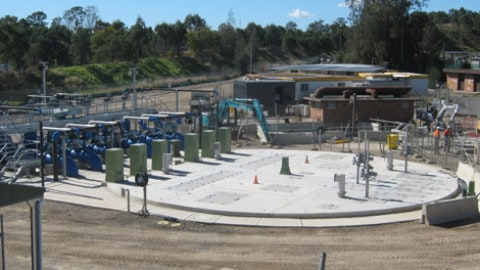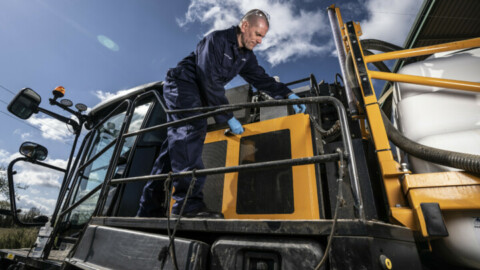Multistage deep well pumps are available in styles and models that range from just one HP, and single stage to multistage versions that often comprise over 20 stages and horsepower levels in the mid four-digit range (Reference 1). Some have their column bearings encased in a tube or inner pipe which allows strict separation between lubricant and the liquid (“pumpage”) being pumped in the surrounding annulus. In other words, the pumpage rises between the inner pipe and a much larger diameter outer pipe. In the second very popular style (Figure 1), there is no separate inner pipe. On its way from pump suction to discharge, the pumpage makes contact with the column bearings, one of which is shown near the centre of the first stage inlet bowl and impeller in Figure 1.

Figure 1: First stage (inlet) bowl, impeller and bottom stabilising bearing (Reference 4).
Fortunately, a few of the very best pump repair companies offer the customer a combination of repair and upgrading.
The “perforated” sleeve bearing in Figure 2 is among them. It can also serve as an intermediate shaft stabilising bushing and a top rebuilder can design and proof-test these and similar bearings to suit specific applications.
As just one of many examples, the clearances at startup may differ significantly from operating temperature in low temperature services, such as low temperature service conditions where startup clearances may differ from operating clearances. A special design may be the solution.

Figure 2: Special line and/or intermediate bushings can be manufactured with per- forations for shaft stabilisation (Source: Hydro Inc., Chicago, IL, also Morwell, Vic., 3840).
In a popular upgrade, unique carbon-filled Perfluoro-Alkoxy (PFA/CF) materials have been used to upgrade the wear rings in virtually every type of pump.
Accordingly, PFA/CF has also become the material of choice for vertical column bearings. Perfluoro-Alkoxies are in the Teflon® family but exhibit a lower coefficient of thermal expansion (CTE) than the metallic wear parts used earlier in a particular pump design.
In mid to large-size vertical column pumps similar or identical to Figure 3, today’s overall mechanical design and reliability meet many of the
expectations of modern pump users.
Such pumps are now often equipped with their own oil-lubricated thrust bearing assembly whereas, in decades past, they depended on motor thrust bearings alone. This is why some older vertical pumps deserve closer scrutiny.
Depending on failure frequency, and assuming relatively frequent thrust bearing distress, upgrading to superior bearings and lubrication methods may be cost-justified. Whenever in-house cost justification data are not available, the probable returns on investment for such upgrades are easy to calculate.
Several rule-of-thumb approaches are given in Optimized Equipment Lubrication, Oil Mist Technology, and Storage Preservation (Reference 2). If existing cold service deep well vertical pumps were purchased from the lowest bidder and/or with an inadequate purchase specification, they may be good candidates for upgrading at the next routine repair or maintenance opportunity. So, how does their failure frequency compare to that of similar pumps located at a nearby best-in-class competitor facility?

Figure 3: Mid-size deep well vertical column pump, with discharge flange and motor mounting surface in foreground (Source: Hydro Inc., Chicago, IL; also Morwell, Vic., 3840).
Determining the adequacy of the mechanical design of large vertical pumps, and especially pumps in low temperature service, merits close consideration of many issues (Reference 2 and 3). Ask if your old installation reflects best practices and widely accepted rules of thumb for vertical column pumps:
- The dn-value of the bearings (shaft rpm multiplied by the mean bearing diameter, in mm), should not exceed the experience-based limit of 500,000 (Reference 3)
- Disclosure of mechanical seal pv-values (pv = pressure times velocity), also seal component materials and seal balance ratios is needed (Reference 4). Working with a respected manufacturer, reliability- focused users should verify the pv-values against prior experience. In case of unusually high pv-values, the locations of satisfied users and names of contact persons may need to be established for follow-up verification

Figure 4: Mid-size deep well vertical column pump, with inlet bowl in foreground (Source: Hydro Inc., Chicago, IL; also Morwell, Vic., 3840).
- The line bearings or column bushings used for shaft stabilisation (Figure 2) can be used to upgrade the vertical pump shown in Figure 3 and 4. The same applicability is true for virtually every other type and size of pump. Upgraded bushings are made of a high-performance polymer material, such as the carbon fibre-filled Perfluoro-Alkoxy Ref. 5. The typical diametral clearance should be [(0.001) (Shaft Diameter, in) + 0.002 in] inches. For a nominal shaft diameter of 1.6875 inches and operation at standard temperatures, the in-service bushing bore should thus be 1.6912”+/-0.0005”. However, these clearances will be different for low operating temperatures. Three or four axial grooves are usually provided in the bore to counteract fretting risk during occasional, but potentially severe, rubbing contact
- A nominal diametral clearance of 0.010 inches is recommended for the bore of labyrinth bushings not serving as bearings
- If vibration probes are used, they should monitor both high-frequency acceleration and low-frequency velocity. Gradually developing bearing defects will show up in the acceleration spectrum long before there are velocity excursions. During shop testing, the pump manufacturer should verify the absence of resonant vibration. This is especially important in variable-speed vertical pumps and resonant vibration must be absent at all anticipated operating speeds
- Hand-fitting of keys and bottom-radiusing of keyways should be considered (Reference 2) and roll-pins should not be used for key fixation. It can be shown that improved shop practices along these lines will increase the shaft factors of safety
- Pay attention to proper assembly procedures (Reference 4). Bearing manufacturers have long insisted on either supporting the bearing inner ring while pushing on a shaft or, alternatively, while pushing the bearing inner ring on the shaft
- O-ring selection varies with the fluid being pumped. Teflon® wrap over Nitrile® rubber or Viton® cores should be considered for olefins services. The final selection should be approved by an O-ring or mechanical seal manufacturer

Figure 5: Cartridge-style dual seals are a widely-used upgrade component in cold service deep well vertical pumps (Source: AESSEAL, Inc., Rotherham, UK and Rockford, IL).
- In cryogenic temperature environments and where dual seals (Figure 5) are used, a specially formulated low pour-point synthetic lubricant will be advantageous as a barrier fluid
- There is universal agreement among bearing manufacturers that an oil spray or oil mist introduced into the bearing cage (the “ball separator”) of pumps and electric motors with rolling element bearings is the most desirable lubricant application method. Either an oil spray or oil mist greatly reduce the risk of overheating – of primary concern in pump geometries where several rolling element bearings are assembled as a stack of two or more bearings. This is an especially important recommendation for low temperature process pumps
References
- Bloch, Heinz P. (2020), Fluid Machinery: Life extension of Pumps, Gas Compressors and Drivers, DeGruyter Publishing, Berlin/Germany, ISBN 978-3-11-067413-2
- Bloch, Heinz P.; Ehlert, Don; Geitner, Fred (2020), Optimized Equipment Lubrication, Oil Mist Technology, and Storage Preservation, Reliabilityweb.com, Ft. Myers, FL., ISBN 978-1-941872-98-7
- Bloch, Heinz P. (2012), Pump Wisdom: Problem Solving for Operators and Specialists, John Wiley & Sons, Hoboken, NJ, ISBN 978-1-118-04123-9
- Bloch, Heinz P. (2017), Petrochemical Machinery Insights, Elsevier Publishing, Oxford (UK) and Cambridge (Massachusetts, USA), ISBN 978-0-12-809272-9




















